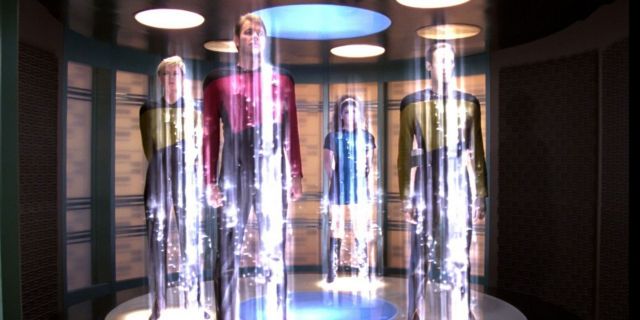Highlights
- The pattern buffer is crucial for safe transport, holding data stable and intact to prevent loss or corruption during travel in Star Trek.
- Transporters scan and break down subjects to a data stream, stored in the pattern buffer to reassemble correctly at the destination.
- Real world physics and technology limitations make Star Trek’s transporter system, including the pattern buffer, purely fictional.
Star Trek‘s transporter is one of the most iconic and intriguing inventions in science fiction. But what makes this seemingly magical technology tick, and could such a thing even be possible within physics as we know it? The answer lies in the concept of the pattern buffer, a crucial component that ensures the safe and precise transport of individuals and objects across vast distances.
Understanding the pattern buffer requires examining the inner workings of the transporter system. Some fans may know that the Heisenberg Compensator is responsible for overcoming the observer principle of quantum mechanics. Meanwhile, the pattern buffer’s role is to maintain the molecular integrity of a person or object during transport.
The Inner Workings of the Pattern Buffer

During the process of dematerialization, the transporter scans the subject and breaks it down into a data stream. This involves mapping every atom and molecule to create a fixed image at the quantum level that can be reconstituted at the other end of the transport.
However, before the transport is completed, this data stream is first held in the pattern buffer, a sophisticated memory device capable of storing immense amounts of information. The buffer ensures that the data remains stable and intact, preventing loss or corruption during transport. At the target destination, the pattern is reassembled into its original form, with the pattern buffer’s data ensuring the correct placement of every atom. Only after this process is complete does the system wipe the buffer. Without this feature, any glitch in the transport could result in the permanent loss of whatever was being transported. Naturally, that would hamper Starfleet’s safety record.
The concept of disassembling a person at the molecular level and reassembling them elsewhere raises profound questions about identity and consciousness. For example: Is the person who materializes at the destination the same individual who dematerialized, or a perfect copy? Episodes like “Second Chances” from Star Trek: The Next Generation explore this question. In this instance, a transporter error left a clone of William T. Riker stranded on a desolate planet for years. In that case, the pattern buffer did its job at both ends of the transport. The outgoing transporter’s buffer saved a copy of Riker, but so did the receiving transporter. The failsafe system for both transporters activated, and the outgoing transporter recreated Riker’s pattern, even though he had successfully materialized on a ship in orbit.
Another example arises in “Tuvix” from Star Trek: Voyager. The episode explores the concept of individuality and a person’s right to choose their own existence, even when that existence comes at the cost of those without the ability to choose. These ethical and psychological quandaries are the bread and butter of the Star Trek series. In true sci-fi spirit, they help viewers explore the complex interplay between advanced technology and the human experience.
There are also numerous examples of transporter technology being used in positive ways throughout Star Trek. The ability to store patterns within a pattern buffer has saved lives, and offers a deep pool of fascinating storytelling to explore. For example, James Montgomery Scott survived for decades inside a pattern buffer after his starship crashed into a Dyson Sphere in The Next Generation. And in Strange New Worlds fans got a look at how transporter technology might be used as a triage tool for battlefield medicine. By keeping wounded soldiers inside a pattern buffer, they could potentially be held in stasis until the medics had the time and resources to save their lives.
The Making of Star Trek: Bringing the Pattern Buffer to Life
Gene Roddenberry, the creator of Star Trek, initially did not envision transporters as part of the series. The book The Making of Star Trek, by Stephen E. Whitfield and Gene Roddenberry, revealed that Roddenberry wanted to have scenes in every episode of the Enterprise landing on a planet’s surface. This quickly proved prohibitive, given the series’ budget. Even trying to depict shuttlecraft landing on a planet would have been too much for consistent use.
Faced with these difficulties, the special effects team devised the transporter as a cost-effective alternative for the pilot episode, “The Cage.” This ingenious solution allowed characters to instantly travel to a planet’s surface without the need for landing sequences. Achieved through a simple fade-out and fade-in effect, the transporter soon became a key piece of Star Trek aesthetic and lore.
Special Effects Evolution
In the 1960s, special effects for the transporter involved overlaying footage and using optical printers to create the shimmering dematerialization effect. Early episodes employed innovative yet simple methods to achieve the glowing effect. The first technique involved filming grains of aluminum powder dropping in front of a black background with a slow-motion camera turned upside down. This footage was then used to transition between shots of actors and the clean background, creating the appearance of dematerialization and rematerialization.
As the series progressed, the special effects team experimented with different materials to enhance the transporter visuals. They filmed dissolving Alka-Seltzer tablets to create a bubbling, dissolving effect, and later used glitter swizzled in a jar of water. These creative solutions allowed the show to maintain its futuristic aesthetic without the need for expensive equipment. The ingenuity of these practical effects laid the groundwork for the more advanced CGI techniques used in modern iterations of Star Trek.
The Pattern Buffer’s Scientific Plausibility

Throughout its history, Star Trek writers and showrunners have consulted with scientists and experts to ground its science fiction in scientific fact. This collaboration has helped maintain the show’s reputation for being thoughtful and intelligent science fiction, rather than simplistic action-orientated or drama-focused storytelling.
Real-World Physics and the Pattern Buffer
The idea of the pattern buffer draws inspiration from scientific principles, even if it remains firmly in the realm of science fiction. Quantum mechanics, for instance, involves the scanning and storing of molecular data, resembling the principles of quantum states and entanglement. The precise measurement and replication of quantum states could, in theory, allow for the transfer of matter. However, storing a person’s molecular pattern involves handling an astronomical amount of data.
Real-world research has been done on quantum teleportation, where the state of a particle is transmitted to another particle at a distance. This research hints at the possibility of transferring information instantaneously. However, as the noted physicist Lawrence Krauss, who wrote the famous book The Science of Star Trek, points out:
Quantum teleportation does for a single atom essentially what the transporter is supposed to do for people. The phenomenon is possible with single atomic states only because of the weirdness of quantum mechanics. If people were quantum mechanical, we could run into walls and every now and then we could go through them. That hasn’t happened for anyone I know, but you can try and experiment if you want. So we’ll be able to do this for single atoms or molecules, but not for Hungarian goulash or people.
Challenges and Limitations
Depending on how you decide to count them, the human body consists of at least 37.2 trillion cells, each containing complex molecular structures. (This doesn’t even take into account the microbes that make up a large portion of a human being’s mass.) The data required to store even the most conservative degree of information at these scales exceeds current computational capabilities. We would need to stack the largest hard drives humanity has, end to end, from Earth all the way to the center of the galaxy to make it work.
There’s also the problem of energy. The pattern buffer works by storing an object after it is deconstructed by the transporter. However, the energy needed to dematerialize and rematerialize a person would be somewhere in the realm of a 1,000-megaton nuclear bomb. Then there’s the issue of ensuring the accuracy of the stored and transmitted data. This, of course, is a crucial part of the process, as any error in the pattern could lead to disastrous consequences during reassembly. Even if the energy issues and storage problems could somehow be solved, real-world physics doesn’t have anything close to Star Trek‘s Heisenberg Compensator to solve the problem of tracking quantum states.
The pattern buffer in Star Trek remains a fascinating part of the larger concept of the transporter, blending imaginative storytelling with the classic scientific-sounding “Treknobabble” that fans of the series have become known for. While the technology is (and will likely always be) fictional, it continues to inspire fantastic stories within the Star Trek universe. As the franchise explores the boundaries of physics and technology, the dream of instantaneous travel helps fans the world over imagine new vistas and new frontiers.











Leave a Reply